Explore the Isle of Man in 3 days
Bank holiday weekends provide a perfect opportunity for a short trip away from home. Yet, with the Brexit disaster fast approaching, weekend breaks in Europe may soon be a thing of the past. Halfway between Great Britain and Ireland, lies the Isle of Man, a small island in the Irish Sea, which is neither a part of the United Kingdom, nor of the British Overseas Territories (such as Gibraltar, Bermuda, the Cayman Islands, the Falkland Islands, and 10 other territories spread across the world). The Isle of Man, the Bailiwick of Jersey and the Bailiwick of Guernsey are the three so-called Crown Dependencies; all three of them are located off the coast of Great Britain and basically are self-governing territories for which the UK is responsible, as opposed to sovereign (independent) states. Interestingly, none of the three has even been part of the European Union.
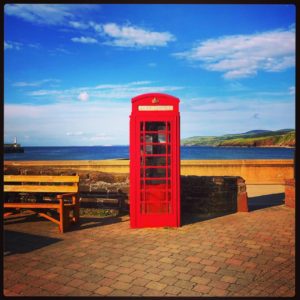
The Isle of Man is by far the largest of the three Crown Dependencies. However, it is small enough to allow a first-time visitor to fully explore it in three days. Given its close proximity to both Great Britain and Ireland, and the fact that there are scheduled flights from 10 UK and Irish airports (including London Gatwick, London City, Birmingham, Manchester, and Liverpool in England), the Isle of Man is easily accessible and ideal for a bank holiday weekend (or any extended weekend for that matter). I would recommend taking an evening flight on a Friday (I took an EasyJet flight from London Gatwick departing at 19.15, and landing to the Isle of Man an hour later), staying in the capital, Douglas, for three nights, and departing Monday evening. You can then follow the following itinerary:
Explore the Isle of Man in 3 days
Day 1 (Saturday):
Start your weekend by having breakfast (and of course tea) at the Tea Junction, where you can choose from over twenty varieties of loose leaf tea and infusions (I had a cup of chocolate and coconut tea, which was utterly delicious). Situated in Castle Street, Douglas, the Tea Junction is the Isle of Man’s first true tea shop.

Then, take the Steam Railway to Port Erin, a calm seaside village in the southwest of the Isle of Man. Opened in 1873, this narrow gauge steam railway is the longest of its kind in Britain that still uses its original locomotives and carriages. The journey takes about an hour and will take you back to time, and then to Port Erin. Here you can walk along the sandy beach, have an ice cream (it will have to be the locally-produced Davison’s), and then a glass of wine (or two) at Foraging Vintners, a seaside winery specializing in non-grape based varieties of sparkling wine. Afterwards, you can take the bus towards Douglas, stopping at Port St Mary, a small village between Port Erin and Castletown, and then at Castletown. This beautiful town used to be the capital of the Isle of Man up until 150 years ago and is dominated by Castle Rushen, a well-preserved medieval castle, which was originally built for a Viking king.
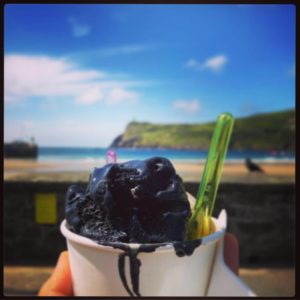
Return back to Douglas, where you can have dinner at the Tanroagan Seafood Restaurant, not too far from the Steam Railway terminus. This was a restaurant recommended to me, but unfortunately I didn’t have the chance to dine there. Alternatively, you can have dinner onboard the steam train. The Pie Mash train departs from Douglas at 19.00 and returns at 22.30 on most Thursdays and Saturdays (£29pp). On some Saturdays, however, the Pie Mash train gets replaced by a Murder mystery train (£49pp). If you happen to be on the Isle of Man on a Friday evening, you can dine on the Curry Club, Tapas and Jambalaya Jazz trains (£29pp).

Day 2 (Sunday):
Begin your Sunday with breakfast at the Market Hall. Here you will find NOA Bakehouse as well as a cycling hub. Then, take the Douglas Bay Horse Tramway along the Douglas Promenade to the Manx Electric Railway terminus (Derby Castle) at the Onchan end of the Promenade (£3). Established in 1876, this is the oldest horse-drawn passenger tramway to remain in service anywhere in the World.

Then, take the Manx Electric Railway to Laxey, where you can board the Snaefell Mountain Railway, which will take you to the top of Snaefell, the Isle of Man’s only mountain. On your way there, you will encounter the Laxey Wheel, the largest waterwheel in the world. From the summit, you can see seven kingdoms: England, Ireland, Scotland, Wales, and Mann, as well as Heaven, and Neptune (a.k.a. the Sea). Of course, this depends on the weather; even though the summit is only at 2036 feet (621 meters) above sea level, the fog may obscure the view.

Return to Laxey and continue on the Manx Electric Railway northwards to Ramsey, the second largest town on the Isle of Man. All these routes are very scenic, so have your camera (or smartphone) handy. The Manx Electric Railway has both closed and open carriages, whereas the Snaefell Mountain Railway has only a closed carriage.

On your return to Douglas, there are several dining options near the Manx Electric Railway terminus; Port Jack Chippy & Diner renowned for its fish and chips, the Terminus Tavern, a cozy pub serving homemade food, or Mama’s Kitchen, a fast-food eatery staying open till the small hours.
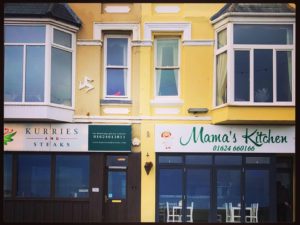
Day 3 (Monday):
On your last day on the island, take the bus to Peel, a seaside town on the west coast. The Peel Castle is the port town’s main attraction; it is situated on St Patrick’s Isle, which is connected to Peel by a small causeway. Stroll around the castle, then head to the promenade, where you can have fish and chips at the Cod and Castle, and ice cream at the Davison’s Parlour. Make sure you leave plenty of time for your return back to Douglas, and from there to the airport, as the bus services on the Douglas-Peel route are not very frequent and sometimes not very reliable either.
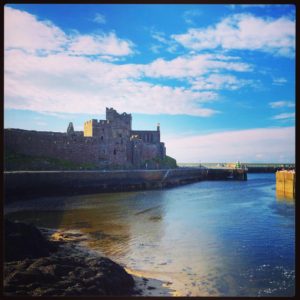
3 interesting facts about the Isle of Man
Whilst preparing for my trip to the Isle of Man, and of course whilst I was there, I learned a few interesting facts about the island, which I would like to share here.
3 legs
Since the Isle of Man is a self-governing territory, it has its own flag, which is as ubiquitous on the island as it is unique. It consists of a triskelion, composed of three white legs with golden spurs, on a red background. But, what exactly is a triskelion? Derived from the Greek language, this little-known word literally means ‘three legs’, and refers to a motif consisting of a triple spiral exhibiting rotational symmetry. A triskelion is actually an ancient symbol, and it is not clear how it ended up part of the Manx coat of arms, and the flag of the island. Unique though the flag is, it bears resemblance to the flag of Sicily, which also features a triskelion, but on a red and yellow background instead.
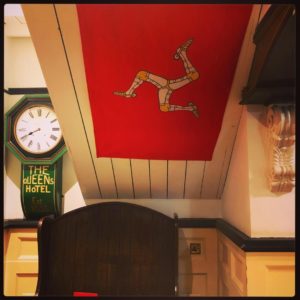
Cats without tails
With a population of just over 80,000 (who are called Manx), the Isle of Man is the birthplace of a worldwide famous music group: the Bee Gees. More importantly, the Isle of Man is the place of origin of a cat breed (also called Manx). Strictly speaking, as Sara Goodwins points out in her book ‘A De-tailed Account of Manx Cats’, the Manx cat ‘is not a true breed in the biological sense’. This is because the phenotype (the observable traits) of the Manx cat (with the lack of a tail being the most obvious characteristic) is caused by a genetic mutation. The allele (the specific gene) responsible for the Manx cat’s tail-lessness is dominant, which means that a Manx (therefore tailless) cat can give birth to kittens with tails (which would therefore not be considered Manx cats).
Norway and the Isle of Man
As much as I love cats, it is no secret that I love Norway and I am obsessed with anything Norwegian (Norwegian Forest cat anyone?). So, I find it imperative to mention the connection between Norway and the Isle of Man. The Norwegian Vikings first arrived to the island as back as in 798 AC, and ruled until the 13th century. During most of that time, the Isle of Man was part of the Kingdom of the Isles, which also comprised the Hebrides and the islands of the Firth of Clyde (which are part of present-day Scotland). In 1266, the Isle of Man also became part of Scotland, and later came under the lordship of the English Crown.
Fast forward to the present and, as already mentioned, the Isle of Man is a self-governing territory that is neither part of the UK nor part of the EU. This small, but nonetheless important, detail seems to have escaped the attention of the current UK Prime Minister, who recently brought the island to the spotlight, when he falsely claimed that EU regulations required kipper suppliers to keep their products cool with ice pillows when delivered. Waving a kipper in the air, Boris Johnson said that a manufacturer from the Isle of Man was “utterly furious” with the EU regulations. He failed to mention, however, that when it comes to smoked products, such as kippers, these regulations are not set by the EU, but by the local governments (i.e. the Isle of Man and UK governments).
Getting there
As already mentioned, there are scheduled flights to the Isle of Man (Ronaldsway Airport) from 10 UK and Irish airports (including London Gatwick, London City, Birmingham, Manchester, and Liverpool in England). From the airport, there are direct and frequent buses to Douglas, Castletown, and Port Erin. Alternatively, you can take the ferry; there are ferry connections from England (including from Liverpool), Ireland and Northern Ireland.
Accommodation
I would recommend staying in Douglas, the capital and largest town of the Isle of Man. There are a lot of hotels on the Promenade; I stayed at the Silvercraigs Hotel, where I had a room with a beautiful view of the Douglas Bay seafront.
When and how long to visit for
The warmer months of the year (May to September) are possibly the best time to visit the Isle of Man. Even then, it may not be particularly warm and sunny. Avoid visiting when the Isle of Man TT (Tourist Trophy) races take place (early June). I would recommend staying there for 3 days.
Further reading
To read more about the Manx cat, check out the book ‘A De-tailed Account of Manx Cats’ by Sara Goodwins.

To follow my travels around the world, simply subscribe to the Traveling Psychiatrist (subscription button on the left-hand side).
My e-book ‘Greek Islands: Top tips by an (almost) local’ is available for FREE for every new subscription (for a LIMITED TIME ONLY).
Have a nice weekend!
Alex
(the Traveling Psychiatrist)